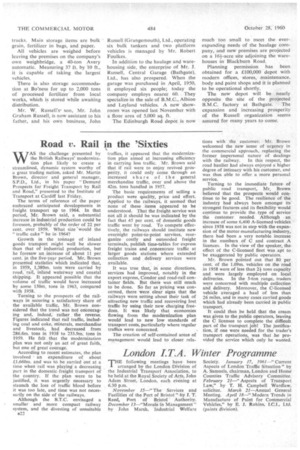Road V. Rail in the 'Sixties W AS the challenge presented
Page 56

If you've noticed an error in this article please click here to report it so we can fix it.
by the British Railways' modernization plan likely to create a streamlined, dynamic system worthy of a great trading nation, asked Mr. Martin Brown, director and general manager, S.P.D., Ltd., in his paper "Demand Prospects for Freight Transport by Rail and Road," presented to the Institute of
Transport at Cardiff last Friday. .
The terms of reference of the paper embraced anticipated developments in freight transport up to 1964. In that period, Mr. Brown said, a substantial increase in industrial production could be foreseen, probably of the order of 22 per cent. over 1959. What size 'would the "traffic cake" be in.1964?
Growth in the tonnage of inland good§ transport might well be slower than that of industrial production, but he foresaw an -.increase of about 11 per cent, in the five-year period. Ur. Brown presented statistics. which indicated that, in 1959, .1,380m. tons were carried by road; rail, inland waterway and coastal shipping. It appeared possible that the volume of traffic would have increased by some 150rn. tons in 1963, coinpared with 1958.
Turning to the prospects of the railways in securing a satisfactory share of the available traffic, Mr. Brown Considered that the trend Was not encoUraging and, indeed, rather, the reverse. Figures indicated that rail traffic, including coal and coke, minerals, merchandise and livestock, had decreased from 286.6m. tons in 1938 to 233.9m. tons in 1959. He felt . that the modernization plan was not only an act of great faith, but one of great courage.
According to recent estimates, the plan involved ' an expenditure of about 11,660m. and was to. be carried out at a time when rail was playing a decreasing part in the domestic -freight transport of the country. If the plan were to be justified, it was urgently necessary to staunch the loss of traffic blood before it was too late, and time was not necessarily on the side of the railways.
Although the B.T.C. envisaged a smaller and more compact railway system, and the divesting of unsuitable B22 traffics, it appeared that the modernization plan aimed at increasing efficiency in carrying less traffic. Mr. Brown said that if rail were to enjoy revived prosperity, it could only come through an increased share of the general merchandise traffic, over and above the 42m. tons handled in 1957.
The basic requirements of selling a product were quality, price and effort. Applied to the railways, it seemed. that none of these items appeared to be understood. That the freight service was not all it should be was indicated by the fact that 45 per cent. of domestic goods traffic went by road. To compete effectively, the railways should institute new overnight point-to-point services, reorganize costly and outmoded freight terminals, publish time-tables for express freight trains and eoncentrate traffic at larger goods stations where extended collection and delivery services were available.
It was true that, in some directions, services had improved, notably in the export express, Condor and road-rail container fields. But there wai still much to be done. So far as pricing was concerned, there were clear signs that the railways were setting about their task of attracting new traffic and recovering lost traffic by using their new charging freedom. It was likely that economies flowing from the modernization plan would lead to new low standards of transport costs, particularly where regular traffics were concerned.
The creation of self-contained areas of management would lead to closer rela tions with the customer. Mr. Brown welcomed the new sense of urgency in the commercial apProach, replacing the former impersonal nature of dealings with the railway. In this respect, the road haulier had always enjoyed a higher degree of intimacy with his customer, and was thus able to offer a more personal service.
Turning to the immediate' future of public road transport, Mr. Brown believed that the prospects would continue to be good. The resilience of the industry had always been amongst its strongest features and its flexibility would continue to provide the. type of service the customer needed. Although an increase of some 6,400 A-licensed vehicles since 1938 was not in step with the expansion of the motor manufacturing industry, there had been a very notable. increase in the numbers of C and contract .A licences. In the view of the speaker, theeffect of the C-licensed fleet was apt to be exaggerated by public operators.
Mr. Brawn pointed out that 80 per cent, of the 1.09m. vehicles on the road in 1958 were of less than 21 tons capacity and. were largely employed on local deliveries. In the 5-ton range, traders were concerned with multiple collection and delivery. Moreover, the -licensed vehicle averaged a haul of less than 26 miles, and in many cases carried goods which had already been carried in public transport.
It could thus be held that the cream was given to the public operators, leaving the C licensee to complete the difficult part of the transport job! . The justification, if one were needed for the trader's transport operations, was that he provided the service which only he wanted.




















































































































